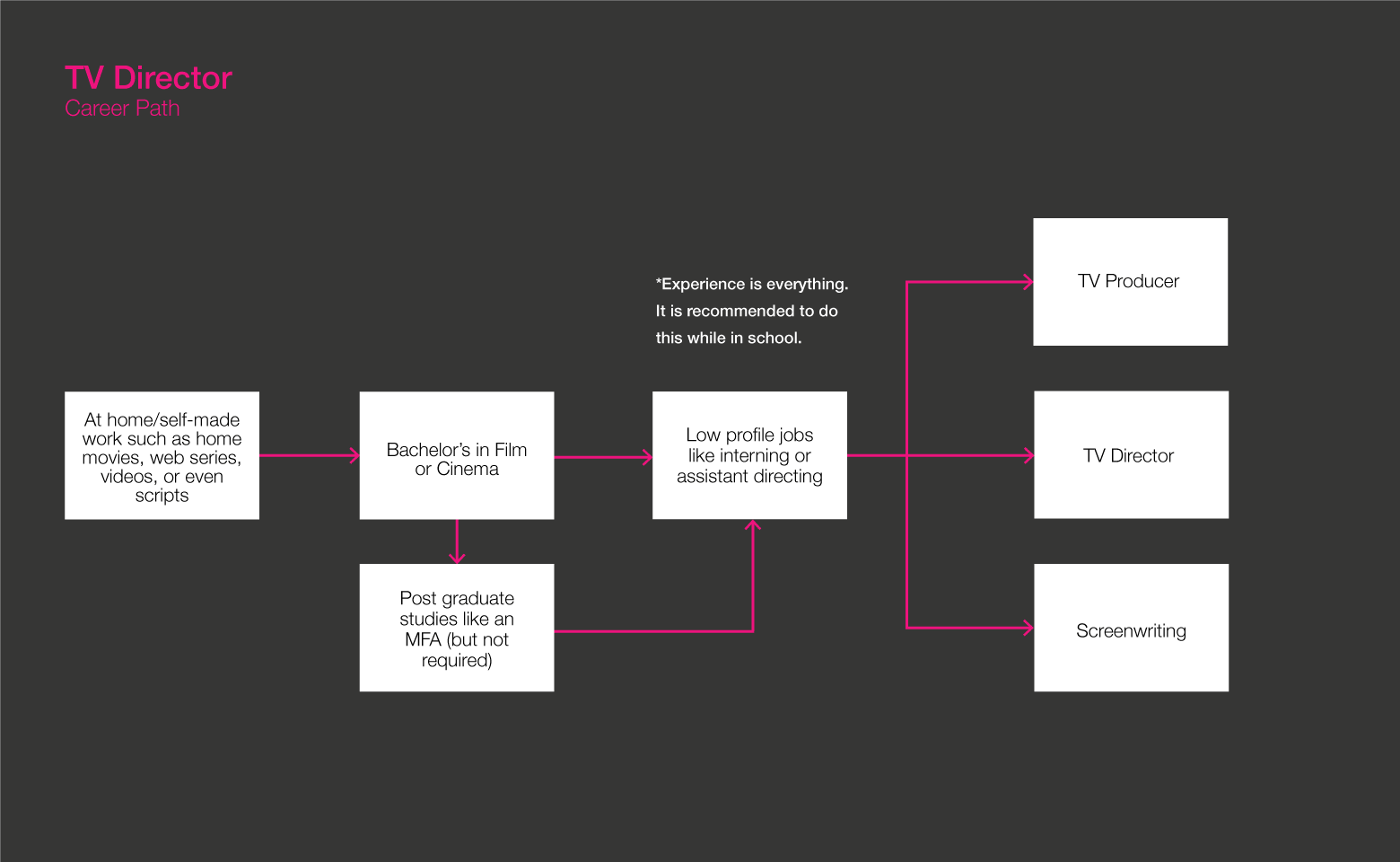Mga spotlight
Television Director, TV Show Director, Episode Director, Series Director, Television Episode Director, TV Program Director, TV Series Director, Television Show Director
Television Directors work closely with writers and producers to create the shows we love to watch on TV! Many shows use multiple directors so they can get the filming done on a compressed timeline. They may also use guest directors to inject some freshness and unique perspectives, without veering too far from the show’s general aesthetic. Sometimes a show may bring on a particular director who has expertise in things like car chases or other action scenes.
Unlike Film Directors, TV Directors may have less input into the stories. Instead, it's their job to capture the vision of the showrunner (aka the executive producer) while doing the legwork to plan and film shoots while overseeing the crew and cast. Different types of TV Directors include Factual TV Director, Entertainment TV Director, Drama TV Director, and Live TV Director, each of which has slightly differing duties and responsibilities. They may also film commercials, working with ad agencies to raise awareness of a brand’s product or service!
- Nagtatrabaho sa isang mabilis na malikhaing kapaligiran
- Capturing performances on camera for shows watched by potentially millions of people for years to come
- Pagtulong na panatilihing nagkakaisa ang cast at crew
Oras ng trabaho
- Television Directors may work full-time when assigned to direct a whole season of a series. In this situation, they may also have to put in a lot of overtime, depending on schedules. Not all TV Directors direct every episode of a show, and some don’t direct any series at all. If a director is brought in to do a single episode, or to film a commercial, play, or other relatively short production, they may have to supplement their income with other work.
Mga Karaniwang Tungkulin
- Review TV show and commercial scripts
- Discuss ideas with the show’s writers, producers, and other stakeholders
- Collaborate with sound, lighting, camera crew, the director of photography, the first assistant director, unit directors, and others
- Ensure the showrunner’s creative vision is understood and captured
- Work with casting directors, if necessary. Most series have their core cast pinned down already
- Work with art departments, wardrobe, hair and makeup, special effects prosthetics, and many other teams to make sure everyone is working cohesively
- Approve set or stage designs, as applicable (some shows have several regular interior sets they use repeatedly, while others may not)
- Go over budgets and financial considerations before production starts. Work with the unit production manager, as needed
- Help actors and other talent understand desired outcomes for each take, without micromanaging performances
- Direct scenes in a variety of settings including interior sets, outdoor location shots, green screen studios, and many more
- Ensure filming stays on schedule and within budget
Mga Karagdagang Pananagutan
- Talk with location scouts to find suitable places for filming particular scenes
- Go over anticipated technical or logistical difficulties such as inclement weather or physical hazards requiring stunt coordination
- Oversee post-production, when necessary (i.e., editing, and Foley sound effects, and adding visual effects such as CGI, compositing, and motion capture)
Isang Halimbawang Araw sa Buhay
- Arrive before 7am
- Answer last minute questions about what the team will shoot that day
- Conduct private, short rehearsal with actors for the first scene
- Show the scene to the crew
- Get marks on every position where the actors stand
- Talk to the DP about how the scene will be shot
- Watch a camera rehearsal with the stand-ins
- Conduct a camera rehearsal with the actors
- Shoot the scene
- Move onto the next scene
- Will shoot on average 5-7 scenes per day
Soft Skills
- Kakayahang magbigay ng inspirasyon sa iba
- Aktibong pakikinig
- Ambition
- Kalmado sa ilalim ng presyon
- Nagtutulungan
- Mga kasanayan sa konseptwalisasyon
- Pagtitiwala
- Pagkamalikhain
- Pagpapasya
- Mabusisi pagdating sa detalye
- Empatiya
- Kakayahang umangkop
- Intuitive
- Pamumuno
- pasensya
- Pagtitiyaga
- pagiging mapanghikayat
- Mga kasanayan sa paglutas ng problema
- Malakas na kasanayan sa komunikasyon
- Pagtutulungan ng magkakasama
- Visual at nakasulat na pagkukuwento
Teknikal na kasanayan
- Knowledge of video camera equipment and filmmaking software, including professional editing tools
- Teknikal na kaalaman sa framing at staging shot
- Familiarity with sound and lighting technologies
- Pamilyar sa disenyo, mga espesyal na epekto, at mga proseso ng post-production
- Pangkalahatang pag-unawa sa mga tungkulin, responsibilidad, at hamon ng lahat ng kritikal na departamento at miyembro ng crew, kabilang ang disenyo ng produksyon, wardrobe, sining, makeup, sound, espesyal at visual effect, set decor, stunt coordinator, cast director, atbp.
- TV and motion picture studios
- Independent Productions
- Mga kumpanya ng advertising at PR
- Mga industriya ng sining ng pagtatanghal
- pagsasahimpapawid sa TV
- Video industries
Without Television Directors, we wouldn’t have anything to watch when we turn on our TVs! Although they don’t have the same level of creative responsibilities as Film Directors, they have complicated jobs that require a huge amount of leadership and multitasking. Luckily, the showrunners, producers, and writing teams take off a lot of the creative burden so that TV Directors can focus on their myriad other duties!
They don’t have to be away as long as Film Directors when shooting on location, but there are still plenty of sacrifices. Hours can be long, with hectic schedules and untold production problems ranging from budgets to logistics. Sometimes TV Directors even have to deal with unruly actors or crew.
Another potential sacrifice is that there may not be a steady paycheck if a director is only brought in for one or two episodes or a brief production such as a commercial. That’s why TV Directors often have to do other work to bring enough yearly income.
TV shows are becoming increasingly sophisticated thanks to the rise of streaming platforms. This has attracted big-name actors who are now more willing to do TV than ever before. Producers have risen to meet the challenge, upping the ante by hiring top-notch Television Directors to make shows that look and feel more like movies.
From Netflix, Hulu, and HBO Max to Disney+, Apple TV, and Amazon, the floodgates have opened and viewers are met with a barrage of exciting new digital content they can binge from their living rooms. While Hollywood is still fighting to reel audiences into movie theaters, streaming has forever changed our viewing habits…which is great news for TV Directors who have more opportunities than ever before! Streaming has also opened things up for documentary makers and independent directors. A few other things:
- Increase in the amount of product for viewing
- “Binge watching” is growing
- Realignment of release windows
- Increased demand for female-focused films
Television Directors were almost certainly huge movie and TV buffs growing up. They may have enjoyed using camcorders or smartphones to shoot amateur videos for YouTube, showing early indications that they weren’t content to simply “watch” but instead had a burning desire to create!
Like all good directors, they were likely innovative and driven, good with both people and technology, and comfortable being in charge of things. In school, they might have been involved in student projects, extracurricular activities, and audiovisual clubs.
Directors tend to know at least a little about a lot of things, and thus might have been voracious readers on a variety of subjects. Perhaps above all, they are storytellers who love to use visual media to share and inspire.
- Most directors need a bachelor’s degree in film, cinema studies, or a similar field. Many complete master’s degrees, too
- Independent directors of small films have no formal educational requirements, but many also hold college degrees or attended formal training
- Ang mga paaralan ng pelikula gaya ng New York Film Academy ay nag-aalok ng mga maiikling programa pati na rin ang mga full degree na programa (tingnan ang aming listahan ng Resources > Film Schools)
- Additional ad hoc certifications such as the New School’s Documentary Media Studies Certificate can bolster your credentials
- Directing requires a slew of people and project management skills, so consider taking courses in communications, leadership, team building, conflict resolution, and project management
- Most film studio directors have years of experience working on sets in assistant director or other roles. Many get their start through studio internships
- The Directors Guild of America offers a highly competitive Assistant Director trainee program
- Directors may also need training on various health and safety issues, as well as state, local, federal, international, and studio policies regarding filming and human resources
- American Film Institute
- Boston University College of Communication
- Dodge College of Film and Media Arts ng Chapman University
- Columbia University School of the Arts
- Florida State University College of Motion Picture Arts
- Full Sail University
- LA Film School
- Loyola Marymount University School of Film and Television
- Motion Picture Institute ng Michigan
- New York Film Academy
- NYU/Tisch School of the Arts
- Paaralan ng Teatro, Telebisyon at Pelikula ng San Diego State University
- Seattle Film Institute
- UCLA School of Theater, Film at Television
- UCLA Extension - Mga Pag-aaral sa Libangan
- USC School of Cinematic Arts
- Pelikula at Teatro ng Unibersidad ng New Orleans
- Unibersidad ng Texas sa Austin Department of Radio-Television-Film
- Mag-stock ng mga kurso sa sining, Ingles, komunikasyon, pagsasalita, sikolohiya, disenyo, at litrato
- Magboluntaryo para sa mga aktibidad sa paaralan kung saan matututunan mo kung paano epektibong magtrabaho bilang isang pangkat, magsanay ng mga kasanayan sa pamumuno, at mamahala ng malalaking proyekto
- Consider signing up for confidence and resiliency courses, so you’ll be able to direct teams and actors even under stressful circumstances
- Sumali sa mga audiovisual club para makakuha ng hands-on na karanasan
- Participate in school and local theater productions
- Simulan ang paggawa ng iyong mga maikling pelikula para sa YouTube o Vimeo. Maghanap ng mga kaibigan at miyembro ng komunidad na gustong sumali sa iyong mga proyekto!
- Borrow or rent video cameras, sound gear, and lighting equipment to get practice
- Become familiar with video editing techniques and software, plus special effects software
- I-advertise ang iyong mga freelance na serbisyo sa paggawa ng pelikula sa lokal na lugar o online
- Maglunsad ng isang online na portfolio upang ipakita ang iyong mga kasanayan at trabaho
- Mag-apply para sa mga internship sa pelikula hanggang sa makarating ka ng isa!
- Pag-aralan ang mga aklat, artikulo, at video tutorial (tingnan ang aming listahan ng Mga Mapagkukunan > Mga Website )
- Don’t just learn about directing. Get to know the ins and outs of every major department involved in filming TV shows, ads, documentaries, etc.
- Dumalo sa mga film festival at film school open event
- Check out Keanu Reeves’ documentary Side by Side, featuring interviews with some of the biggest directors in Hollywood
- Submit your film to a film festival.
- Sumali sa mga propesyonal na organisasyon upang malaman ang tungkol sa mga uso at palaguin ang iyong network

- Lumipat sa kung saan ang pinakamaraming trabaho sa pelikula at TV! Sa bawat BLS, ang mga estado na may pinakamataas na trabaho para sa mga trabahong ito ay ang California, New York, Texas, Florida, at Georgia
- Work with actors and Direct plays
- Malamang na kailangan mong mag-aplay para sa mga entry-level na trabaho at magtrabaho sa iyong paraan hanggang sa mga tungkulin ng Assistant Director
- Many Directors start as production assistants or interns. Even these are coveted positions, so contact your state film commission learn about to upcoming opportunities
- Ipaalam sa iyong network na naghahanap ka ng mga trabaho o internship! Ayon sa CNBC , "Ipinapakita ng pananaliksik na 70% ng lahat ng mga trabaho ay hindi nai-publish sa publiko sa mga site ng trabaho at hanggang sa 80% ng mga trabaho ay pinupunan sa pamamagitan ng mga personal at propesyonal na koneksyon"
- Build your reputation and ensure your work is seen! Enter film festivals, promote your work on social media, and get published in industry journals or on popular websites
- Check out film job sites and forums as well as job portals such as Indeed, Simply Hired, and Glassdoor
Ask your professors, supervisors, and peers if they’ll serve as personal references - Once you have a reel, apply to television director development programs
- Join the DGA union when you’re eligible and can afford the steep initiation fee
- Hop on Quora and start asking job advice questions and requesting answers from working directors
- Makipag-usap sa iyong film school o career center ng kolehiyo para sa tulong sa mga resume, mock interview, at paghahanap ng trabaho
Mga website
- Aksyon-Cut-Print
- Adorama
- Sining ng Guillotine
- Association of Film Commissioners International
- Awardeo
- AWN
- B&H Photo, Video, at Pro Audio
- Mga Network ng Casting
- CheesyCam
- Cinephilia and Beyond
- Corridor Digital
- D4Darious
- Mga Pelikulang Detonasyon
- Direktor Guild ng America
- Tapos na Deal Professional
- Drop.io
- Mga DVcreator
- DVXuser
- Filmmaker IQ
- Filmmaker Magazine
- Filmmakers Alliance
- Riot sa Pelikula
- Tinatanggihan ng Paaralan ng Pelikula
- Filmspotting
- Gabay sa FX
- Pumunta sa Kwento
- Google Art & Culture
- Greenlight My Movie
- Hollywood OmniBook
- IMDb
- Indie Film Hustle
- IndieTalk
- IndieWire
- InkTip
- International Cinematographers Guild Magazine
- John August
- Paggawa ng
- Maltin sa Mga Pelikula
- Mandy.com
- MovieMaker Magazine
- Pambansang Samahan ng mga Paaralan ng Teatro
- Pambansang Endowment para sa Sining
- Noam Kroll
- Walang Film School
- Philip Bloom
- Mag-post ng Magazine
- ProductionHUB
- ProVideo Coalition
- REDUser
- SAGindie
- Script Magazine
- Shanks FX
- Pamamaril sa mga Tao
- Staff Me Up
- Stage 32
- Mga Mag-aaral na Filmmaker
- Studio Araw-araw
- Ang American Society of Cinematographers
- Ang Film Collaborative
- Ang Gotham
- Ang Production Booth
- Twitch
- Kawal ng VFX
- Video Copilot
- Tagagawa ng bidyo
- Video
- Vincent Laforet
- Lipunan ng Visual Effects
- WIRED - Design FX
- ZapSplat
Mga libro
- Directing Great Television: Inside TV’s New Golden Age, by Dan Attias
- Directors Tell the Story: Master the Craft of Television and Film Directing, by Bethany Rooney and Mary Lou Belli
- Studio Television Production and Directing: Concepts, Equipment, and Procedures, by Andrew Utterback
- The Art and Craft of TV Directing: Conversations with Episodic Television Directors, by Jim Hemphill
- Build trust by delivering episodes on time, on budget
- Capture the producers’ imaginations and make them want more work from you
- Patuloy na mahasa ang iyong craft habang natututo din ng higit pa tungkol sa mga tungkulin ng iba
- Treat everyone with respect, always be well-prepared for the day’s shoots, and stay calm and in control
- Build your reputation as a director that actors and crew love to work with
- Direct as many things as you can to expand your portfolio of work
- Itigil ang karagdagang edukasyon at pagsasanay na maaaring mapabuti ang iyong mga teknikal at malikhaing kasanayan
- Watch and learn from more senior directors
- Listen to assistant directors, department leads, and crew members
- Patuloy na palakihin ang iyong propesyonal na network at harapin ang mas malalaking, mas ambisyosong proyekto
- Gawing available ang iyong sarili para sa mga film festival, lokal na kaganapan, kumperensya, at workshop
- Join professional organizations like the Directors Guild of America
- Try to win award and other recognitions that’ll look great on your resume
”Directors direct! If you have an iPhone and a computer, you have the first tools you need to make a short film.....” Mary Lou Belli, TV Director
The job of a Television Director isn’t nearly as glamorous as some people think. It’s can be grueling work (when you actually have any work), with long hours and non-stop duties. Energetic people with the right combination of leadership ability, technical know-how, and storytelling skills can make big names for themselves in this industry. However, it’s not for everyone and that’s understandable. The Bureau of Labor Statistics lists the following related occupations to think about!
- Mga artista
- Mga Direktor ng Sining
- Mga koreograpo
- Mga Editor ng Pelikula at Video at Operator ng Camera
- Mga Artist at Animator ng Special Effects
- Mga Nangungunang Executive
- Mga Manunulat at May-akda
Newsfeed

Mga Tampok na Trabaho

Mga Online na Kurso at Tool

Mga Inaasahan sa Taunang Sahod
Nagsisimula ang mga bagong manggagawa sa paligid ng $82K. Ang median na suweldo ay $109K bawat taon. Ang mga manggagawang may mataas na karanasan ay maaaring kumita ng humigit-kumulang $170K.





